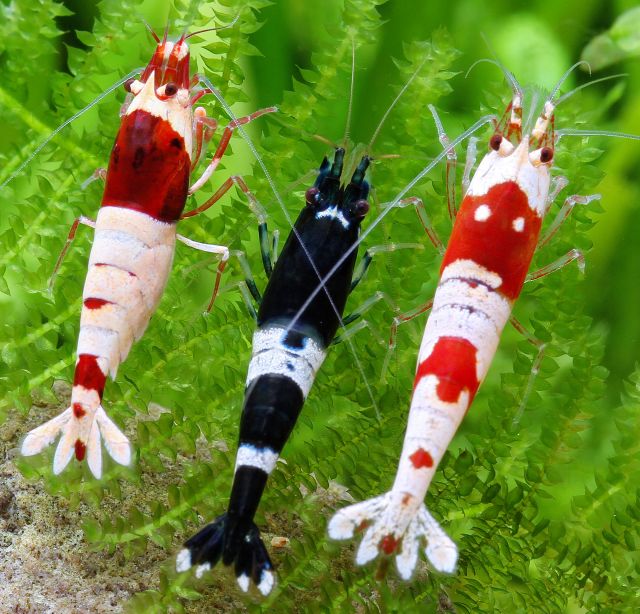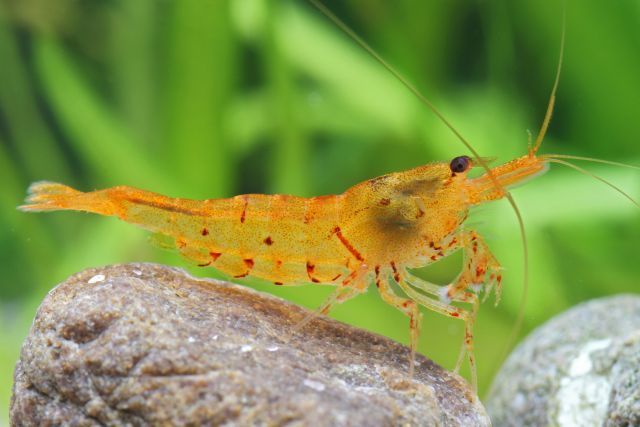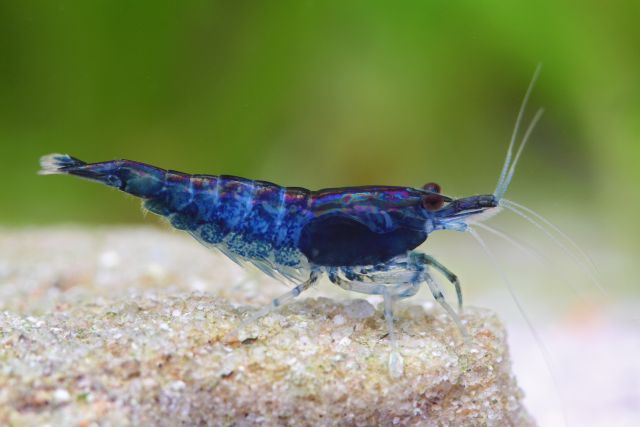If you want to keep a colony of Bee Shrimp (Caridina logemanni), Taiwan Bee Shrimp aka Shadow Shrimp (Caridina sp.) or any other type of shrimp demanding soft water in your aquascape, you should take special care of the water parameters when stones are part of your hardscape.

Bee and Taiwan Bee Shrimp - picture by Chris Lukhaup
Calcareous rocks can release some lime into the water in a soft water aquarium with low or zero carbonate hardness and a pH value in the acidic range below 7.0. In a planted tank or aquascape this is of little relevance, because you can easily push the water hardness back into an agreeable range for the plants by doing your water changes with soft water. Above all, if you don't fertilize your tank with CO2, the hardening effect by the hardscape in a planted aquarium and also in aquariums with fish from soft-water biotopes such as neon tetras is negligible as a rule.
If you change around 50% of the water every week as recommended for aquascapes, the mild hardening effect by the stones has no negative consequences for the plants. In addition to the generous water changes already mentioned, there are other ways of bringing the water hardness back into a favorable range for the aquarium animals: the use of active soil as substrate, which acts as an ion exchanger and so softens the water continuously, or ADA's Softenizer. Oliver Knott explains in his video on the topic "Water-hardening stones" in detail how to deal with water-hardening rocks in a planted tank and how to tell whether the stones that you have selected for your aquascape harden the water. With these methods an aquascape with aquarium plants that love soft water is well taken care of.

Tangerine Tiger - picture by Chris Lukhaup.
The situation is quite different in an aquascape with rather sensitive shrimp that need soft water. Dwarf shrimp from soft-water biotopes such as the Bee Shrimp Caridina logemanni, Taiwan Bee Shrimp Caridina sp. and shrimp of the species Caridina cantonensis and Caridina serrata do not like the presence of carbonate hardness at all - the KH therefore shouldn’t permanently be above 2°dKH in a tank with these ornamental shrimp. These beautiful but rather delicate dwarf shrimp species dislike fluctuations in the water parameters even more. A weekly water change of 50% with soft water - which lowers the accumulated hardness - and the resulting abrupt dilution of the aquarium water's mineral content may have a very negative impact on Bee Shrimp, Taiwan Bees and the like. Strong dilution can cause a big and sudden change in osmotic pressure, which can lead to stress, disease, bad molts and even death in sensitive shrimp species. If you have delicate shrimp in your aquarium, a big weekly water change to lower the water hardness is definitely off the table.
In an aquascape with, for example, Shadow Shrimp or Bee Shrimp it's therefore better not to use any water-hardening materials at all to begin with. If this is not possible for design reasons, then you need to make sure that the hardness is reduced continuously in the best possible way so that no sudden fluctuations in the water values can occur.

The often-recommended use of active soil in combination with water-hardening aquarium rocks has not proven to be particularly useful for aquascapes with soft-water shrimp in the long run. Although the soil constantly absorbs the lime released from the stones, it doesn’t have infinite absorption capacities. If it is constantly "fed" with calcium carbonate, its buffering capacity will soon be exhausted. As the active soil approaches saturation, the carbonate hardness will start to rise slowly and hardly noticeably. If this is the case and you - in all good intentions and with soft water adapted to the supposed parameters in your aquarium - do your weekly water change without checking the actual water parameters in the aquarium first, you may unwittingly cause a fluctuation of the water hardness, with all the consequences mentioned above. If you use active soil in an aquarium with shrimp from soft-water biotopes, and use water-hardening stones for the hardscape, you should always check if the soil is still working, and measure the carbonate hardness at regular intervals. If necessary, the saturated soil needs to be replaced.
ADA's Softenizer is a great alternative, or - even better - a complement to active soil. It uses a special ion-exchanging resin and constantly extracts lime from the aquarium water. The Softenizer is installed inline inside the filter circle and softens the water continuously. The exact principle of operation is explained in this article: "ADA Softenizer - The right water with ADA Softenizers".
We have listed all available aquarium stones from our online store in our Aquascaping Wiki in the article "Hardscape", where we describe the effects on the water parameters (neutral in water or water-hardening) for each and every kind of rock, amongst other things.
If all this is way too much work for you, just pick equally beautiful but significantly sturdier Neocaridina shrimp that have absolutely zero problems with harder aquarium water.

Neocaridina davidi "Blue Dream" - Copyright by Chris Lukhaup.